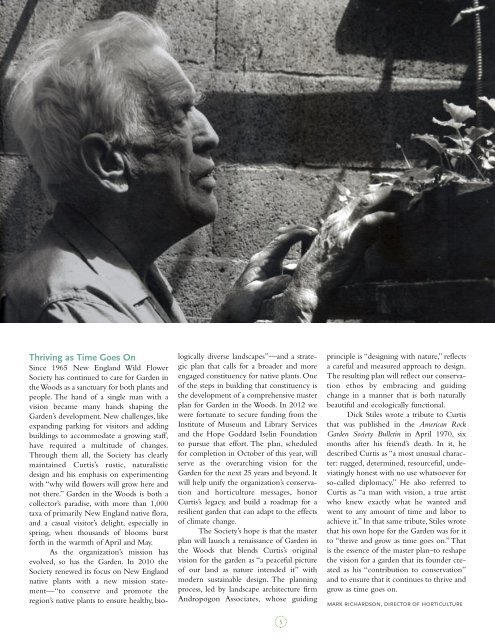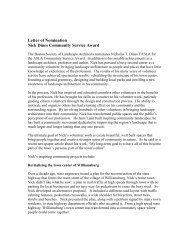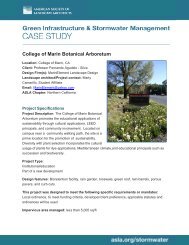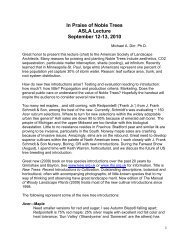(R)evolution: - American Society of Landscape Architects
(R)evolution: - American Society of Landscape Architects
(R)evolution: - American Society of Landscape Architects
Create successful ePaper yourself
Turn your PDF publications into a flip-book with our unique Google optimized e-Paper software.
Thriving as Time Goes On<br />
Since 1965 New England Wild Flower<br />
<strong>Society</strong> has continued to care for Garden in<br />
the Woods as a sanctuary for both plants and<br />
people. The hand <strong>of</strong> a single man with a<br />
vision became many hands shaping the<br />
Garden’s development. New challenges, like<br />
expanding parking for visitors and adding<br />
buildings to accommodate a growing staff,<br />
have required a multitude <strong>of</strong> changes.<br />
Through them all, the <strong>Society</strong> has clearly<br />
maintained Curtis’s rustic, naturalistic<br />
design and his emphasis on experimenting<br />
with “why wild flowers will grow here and<br />
not there.” Garden in the Woods is both a<br />
collector’s paradise, with more than 1,000<br />
taxa <strong>of</strong> primarily New England native flora,<br />
and a casual visitor’s delight, especially in<br />
spring, when thousands <strong>of</strong> blooms burst<br />
forth in the warmth <strong>of</strong> April and May.<br />
As the organization’s mission has<br />
evolved, so has the Garden. In 2010 the<br />
<strong>Society</strong> renewed its focus on New England<br />
native plants with a new mission statement—“to<br />
conserve and promote the<br />
region’s native plants to ensure healthy, biologically<br />
diverse landscapes”—and a strategic<br />
plan that calls for a broader and more<br />
engaged constituency for native plants. One<br />
<strong>of</strong> the steps in building that constituency is<br />
the development <strong>of</strong> a comprehensive master<br />
plan for Garden in the Woods. In 2012 we<br />
were fortunate to secure funding from the<br />
Institute <strong>of</strong> Museum and Library Services<br />
and the Hope Goddard Iselin Foundation<br />
to pursue that effort. The plan, scheduled<br />
for completion in October <strong>of</strong> this year, will<br />
serve as the overarching vision for the<br />
Garden for the next 25 years and beyond. It<br />
will help unify the organization’s conservation<br />
and horticulture messages, honor<br />
Curtis’s legacy, and build a roadmap for a<br />
resilient garden that can adapt to the effects<br />
<strong>of</strong> climate change.<br />
The <strong>Society</strong>’s hope is that the master<br />
plan will launch a renaissance <strong>of</strong> Garden in<br />
the Woods that blends Curtis’s original<br />
vision for the garden as “a peaceful picture<br />
<strong>of</strong> our land as nature intended it” with<br />
modern sustainable design. The planning<br />
process, led by landscape architecture firm<br />
Andropogon Associates, whose guiding<br />
5<br />
principle is “designing with nature,” reflects<br />
a careful and measured approach to design.<br />
The resulting plan will reflect our conservation<br />
ethos by embracing and guiding<br />
change in a manner that is both naturally<br />
beautiful and ecologically functional.<br />
Dick Stiles wrote a tribute to Curtis<br />
that was published in the <strong>American</strong> Rock<br />
Garden <strong>Society</strong> Bulletin in April 1970, six<br />
months after his friend’s death. In it, he<br />
described Curtis as “a most unusual character:<br />
rugged, determined, resourceful, undeviatingly<br />
honest with no use whatsoever for<br />
so-called diplomacy.” He also referred to<br />
Curtis as “a man with vision, a true artist<br />
who knew exactly what he wanted and<br />
went to any amount <strong>of</strong> time and labor to<br />
achieve it.” In that same tribute, Stiles wrote<br />
that his own hope for the Garden was for it<br />
to “thrive and grow as time goes on.” That<br />
is the essence <strong>of</strong> the master plan–to reshape<br />
the vision for a garden that its founder created<br />
as his “contribution to conservation”<br />
and to ensure that it continues to thrive and<br />
grow as time goes on.<br />
mark richardson, director <strong>of</strong> horticulture
















